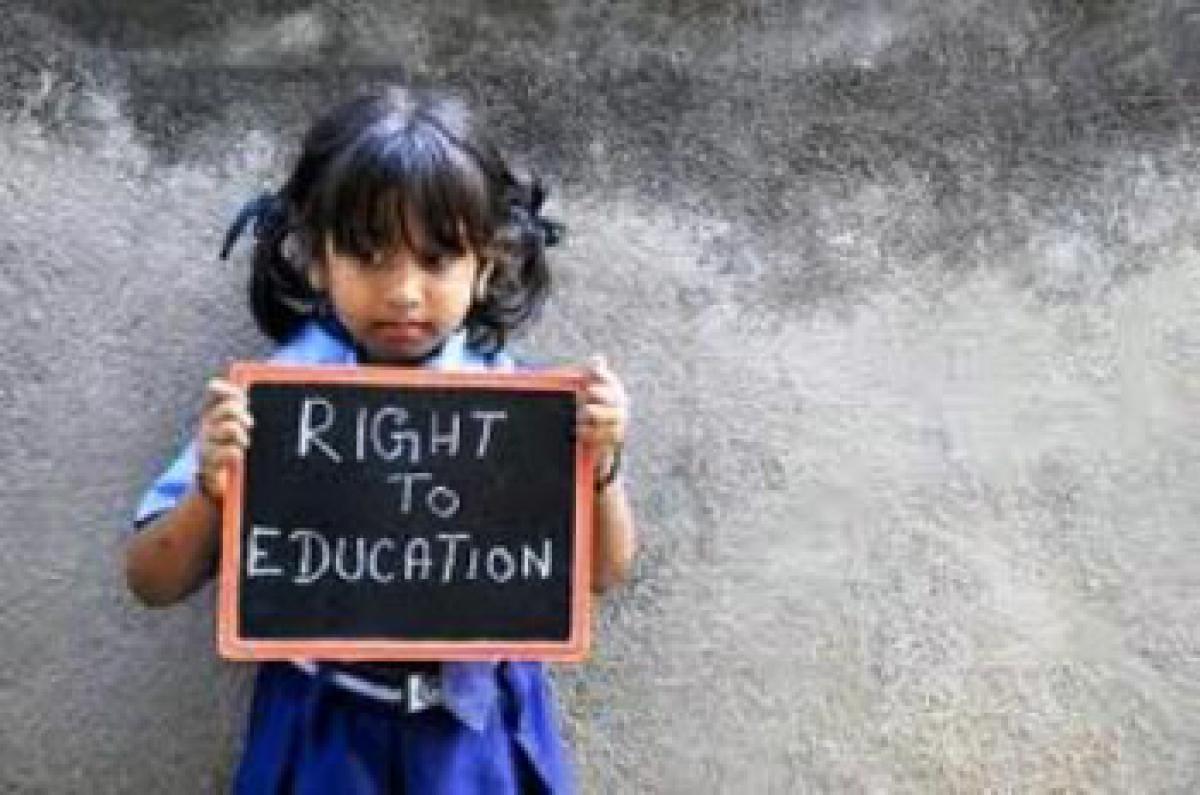Live
- 2 senior professors to join NALSAR
- Former Principal of SPW College passes away in US
- Hyderabad: Govt out to remove electric poles, transformers on roads across city
- KCR goes into huddle with State legal eagles
- Formula E race: KTR to be arrested soon?
- Film fraternity stands with Allu Arjun
- New CUAP campus faces security challenges
- HC grants protection to Allu Arjun from arrest
- Stampede victim’s husband ready to withdraw case against Allu Arjun
- Tomatoes price falls drastically to Rs 1 per kg at Pathikonda agri market
Just In

The Section 12(1)(c) of the Right to Education (RTE) Act mandates that private unaided schools keep aside at least 25 per cent of their entry level seats for children from economically weaker and disadvantaged sections of society.
Out of 22.9 lakh seats under the Right to Education (RTE) quota of 25 per cent in the country in 2014-15, only roughly 3.46 lakh seats were filled, according to a recent report, “State of the Nation: RTE Section 12(1)(c),” by the RTE Resource Centre at Indian Institute of Management (IIM) in Ahmedabad.
- In 2014-15, out of 2.17 lakh schools only 45,996 schools had taken at least one student.
- The top-performing states for filling the RTE quota seats were Delhi (44.61%), Rajasthan (39.26%) and Tamil Nadu (37.75%).
- The worst-performing states were Andhra Pradesh (0%), Telangana (0.01%), Mizoram (0.21%), Uttar Pradesh (0.79%) and Odisha (0.97%)
The Section 12(1)(c) of the Right to Education (RTE) Act mandates that private unaided schools keep aside at least 25 per cent of their entry level seats for children from economically weaker and disadvantaged sections of society.
Most significantly, it potentially provides an opportunity for approximately 22 lakh children to gain access to a school that they are able to choose, relatively unconstrained by their economic ground every year.
According to data compiled by the report, in 2014-15, roughly 3.46 lakh seats were filled out of approximately 22.9 lakh seats available under Section 12(1) (c), resulting in a fill rate of 15.12 percent. This is slight improvement from 3.2 lakh seats filled under the RTE quota, out of 21.8 lakh available seats (14.66 percent fill rate) in 2013-14.
In 2014-15, out of 2.17 lakh schools only 45,996 schools had taken at least one student under this provision. In2013-14, there were 44,158 participating schools out of total 2.06 lakh schools.
The top-performing states for filling the RTE quota seats were Delhi (44.61%), Rajasthan (39.26%), Tamil Nadu (37.75%), Chhattisgarh (32.94%) and Uttarakhand (31.96%). In Maharashtra, only 17.87% seats were filled under the RTE quota, according to the report.
The worst-performing states were Andhra Pradesh (0%), Telangana (0.01%), Mizoram (0.21%), Uttar Pradesh (0.79%) and Odisha (0.97%). According to the report, this data was provided by the District Information System for Education (DISE).
As per report, there are 16,695 schools nationally which have reported fill rate greater than 100 percent. Big states with highest drop in the fill rate, Madhya Pradesh (38.34 percent) has 3,627 schools (out of 23,650 schools) which are showing fill rate greater than 100 percent. The numbers for Karnataka (34.1 percent drop) are 1,732 schools out of 12,190 schools.
The report notes that for tracking the dropouts under Section 12(1)(c) nationally, according to it, Telangana with lowest dropouts (0%) tops the list, followed by Andhra Pradesh with (9.02%) dropouts. The highest dropouts noted in Odisha 96.36 percent Arunachal Pradesh 94.44 percent Sikkim 91.00 percent Nagaland 90.49 percent Kerala 89.94 percent.
The report also pointed out that most states have either unclear rules or guidelines are not implementing the RTE Act properly and awareness is still erratic, especially in rural areas. Once children enter the school system, provision for supporting and child tracking is almost non-existent.
The report also found that one of the reasons for low school participation rate was the delay in reimbursement to schools for admitting students under the provision. To address this, the report recommended clarity on the methodology for computing and updating per child recurring expenditure and publishing it in the public domain.
It also recommends ensuring reliable and timely reimbursements by streamlining the processes, transferring funds on time to districts, reviewing manpower needs, and coordinating with banks to ensure that schools were reimbursed on time.
The report also reveals that of the Rs1,466.5 crore requested for RTE quota admission implementation, only Rs250 crore was approved by the Centre. Only six states – Chhattisgarh, Gujarat, Karnataka, Odisha, Rajasthan and Uttarakhand – got any assistance from the Centre. Ensuring smooth flow of money from the state to the school is crucial for effective implementation.
The report claims that in top performing states, the civil society has played a critical role in improving the implementation. They have done it by disseminating information and creating awareness about the policy among beneficiaries.
Eventually, the report recommends that States which have made RTE provision difficult to implement by putting preference of filling government/ government aided should revise their rules. Similarly steps towards strengthening the implementation structures- whether by having a separate RTE commission or by building an effective MIS system- are still critically important.
It also recommended, the process of tracking children admitted under this mandate should be instituted to check for the desired level of implementation and outcome. This involves tracking children admitted under the RTE 25 percent quota for attendance, grades, dropout rates, frequency of parent interaction, learning outcomes etc.
In addition to this, state governments can administer simple tests to detect any cases of systematic discrimination against children admitted under the quota. The states should also launch a foll-free helpline number, where the parents can register their complaints regarding non-compliance of this policy. This number should be printed on every application form and should also be provided along with the receipt.

© 2024 Hyderabad Media House Limited/The Hans India. All rights reserved. Powered by hocalwire.com







